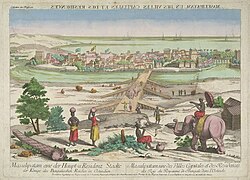President of Danish India
Short after his takeover, Pessart would assume the title of president. [3] Early on he would be described as a drunken and reckless libertine, who brought confusion to all merchants. [3] He would reside in Masulipatnam [c] instead of Tranquebar, which he would leave to chief merchant Jacob von Stackenborg. [3]

Masulipatnam was the center of the cotton trade, which was heavily demanded on the Sunda Islands. [4] Though you could also buy tobacco, iron, steel, indigo dye, and various gems. [4]
In late 1639 English, Danish, and Dutch agents in Masulipatnam were given the order to meet with the Golconda king. [5] When meeting the king, he demanded that they give him 600.000 pagodas, as the local governor had promised. [5] The Dutch scrapped 3.000 padogas, an elephant, and five Persian horses. [5] The English could not muster anything, to which the king got mad and expelled the English from Masulipatnam. [5] The Danes got away with promising 2.000 pagodas when the next ship from Denmark had arrived. [6]
Moreover, Pessart would encumber large debts from the start of his administration, and he would attempt several risky voyages to make money. [7] Pessart ignored the Danish East India Company's most profitable commercial contacts, like Thanjavur and Makassar, to instead trade in less certain places Like Persia. [7] He would also ignore Tranquebar which fell into chaos. [d] [7]
Financial difficulties
Bottom: Danish settlements, factories, and trade routes during the end of Pessart's administration and afterward.
These difficulties forced Pessart to experiment with Diamond trade in the region, which he sought to sell on Sumatra. [6] He also sent a ship to Persia hoping to gain profit, yet the goods could not be sold for financial gain. [6] Amid the difficulties, Pessart tried to sell Fort Dansborg and Tranquebar to the Portuguese, in that the headquarters now had moved to Masulipatnam, though the Portuguese would reject this offer. [6] A similar offer was given to the English but to no avail. [6]
The financial difficulties culminated in the Loss of the St. Jacob in 1640. [8] The ship was on its way home when it got hit by a hurricane and was wrecked off the coast of Pipeley. [8] Pessart estimated the initial loss to be about 150.000 Danish rigsdaler and would take a big hit on the company's economy. [8] Additionally, 16 Danes would die in Bengali imprisonment. [8] When the creditors in Masulipatnam, who had already gotten frustrated over Pessart's debts, heard about this, they demanded he be arrested. [8]
War with Bengal
Pessart and the Danes viewed the loss of the St. Jacob as a tyrannous act by the Bengalis, because of their lack of help and imprisonment of the Danish crew. [9] Appalled, Pessart sent a formal declaration of war in 1642 and sent two Danish vessels to attack Bengal, in which they captured a large ship they renamed Den Bengalske Prise. [9] The ship was then brought to Tranquebar, equipped with cannons to join the small operating Danish fleet. [3] The privateering war would be continued by Pessart's successor Willem Leyel and succeeding governors.
Arrival of Willem Leyel
The rumours of Pessart's debts had long reached Copenhagen, and in response, Captain Willem Leyel would embark for Dansborg reaching it on 5 September 1643. [3] Pessart did not welcome his arrival, and he would quickly leave for Masilupatnam, which Leyel opted to join. [3] On their arrival in Masulipatnam Leyel was confronted with the large debts Pessart had encumbered. Upon hearing this, they continued to Emeldy, where Pessart would accidentally wreck the Den Bengalske Prise, though he would safely arrive in the town. [10]
Witnessing all of this, Leyel decided to arrest Pessart while in his tent, although when confronting his tent, Pessart had already left Emeldy for Tranquebar, with Leyel hastily pursuing. [10] Pessart reached Tranquebar safely and quickly began the preparations for a further departure. [10] He instructed the commander of Fort Dansborg Jacob von Stackenberg to deny Leyel access to the fort and bought a yacht in Portuguese Nagapattinam, which he would use for his escape. The vessel was renamed Dend Gode Haab and had been filled with good cargo, which it was to sell in Japan. [11]


